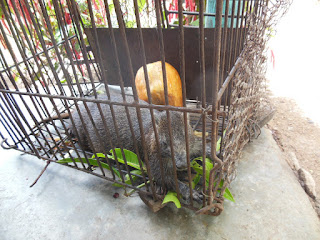We boarded a bus at about 7:45 with Ashbal, our guide for the day. After picking up people at several other hotels, Ashbal began a bilingual quiz to see how much we all knew about Cuba in general, and Matanzas in particular. I’m afraid we didn’t do very well, but learned a great deal in the process. And it was bilingual in English and German!
Our first stop was at the Canimar River which runs out of the mountains into Matanzas Bay. The sides of the gorge at the mouth are quite high, and we took a boat up the river for a bit while Ashbal told us about the birds and animals native to the area, as well as some of the history of the river. They have found evidence of ancient people living along its banks for thousands of years.
Next, we visited the Bellamar Caves high in the hills. These caves were discovered in the 19th century by a worker on the local ranch. He was trying to break up some of the limestone with an iron bar, when that bar fell through a hole and disappeared. Trying to recover his iron bar, the man put a light into the hole, and saw his light reflected by thousands of crystals. The cave system is extensive, but most of it is protected and closed to regular tourists. We were allowed into some of the larger chambers, and descended about 750 meters on slippery and uneven steps and rock paths. There were huge formations all around, and a large underground pool of water at the end of our path. It was very hot, and extremely humid, making us all move slowly, especially on the climb back up. The small bar located outside was very popular with our group after we surfaced, and sold a number of beers and mojitos, even though it was only 11 am.
Our destination was Rancho Gaviota, where we were greeted by a big old billy goat and his small herd.
We had a typical cuban lunch of soup, meat, rice and beans, veggies, and guava with cheese for dessert. Chickens and turkeys ran freely around the ranch house, and we sampled fresh mango, coconut, cane juice and many other products produced on the ranch. We saw pineapples, coffee and avocados growing. Working horses are everywhere, not just on the ranch but also in the many small villages we drove through to get there. They are still a way of life for many as farming machinery is virtually nonexistant for the average citizen.
This is a tree rat being kept in a cage at the ranch. They live along the Canimar River and are evidently related to beavers and other large rodents. We are told that they are delicious to eat!
Before getting to Matanzas, we stopped at the lovely Ermita de Monserrate.
Built in 1875 by the Catalan society of Matanzas to commemorate the Virgin of Montserrat, its location atop a hill overlooking the city and bay of Matanzas was chosen because it reminded them of the original shrine outside Barcelona. It has been beautifully restored in recent years, and it was being decorated for a wedding when we arrived. Visitors are invited to pay one peso to climb the spiral stairs to the bell tower, and ring the bell to let the angels know you are there. Normally, you would think that coming down would be easier than climbing up, but in this case I’m not so sure!!
Finally, we made it into Matanzas, which means ‘slaughters’ in Spanish. Historians don’t necessarily agree on the details, but the do agree on the general explanation that the Spanish did kill a large number of aboriginal people here in their early conquest of the island. Matanzas is also known as the City of Bridges because there are 29 bridges spanning a number of rivers and inlets around the end of the bay.
Once again, we were struck by the contrast of lovely, well maintained homes right next to crumbling ruins. Huge old mansions have been converted into apartments, and the historical areas around the squares are generally in good condition.
We visited the Triolet Pharmaceutical Museum – home of the oldest pharmacy in Matanzas (founded in 1882) until it closed in 1964 and was turned into a museum. It still hold hundreds and hundreds of jars, bottles, record books and recipes for nearly 1.5 million plant based remedies.
Across the square from the pharmacy is the old Spanish Casino, a music hall and a theatre.
A few blocks away is the Catedral de San Carlos, completed in 1840. While the outside remained, inside was completely destroyed by time and neglect, until the city asked for it to be restored. As the provincial capital, the city pointed out that Matanzas province was the only province in Cuba without a functioning cathedral, and eventuall permission and money was provided. The restoration was completed in 2016, and it is breathtaking.


















































